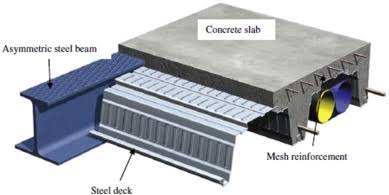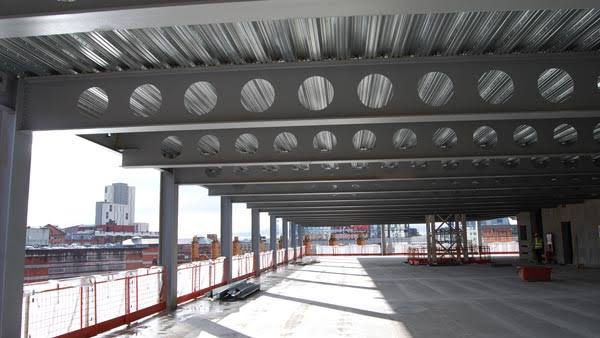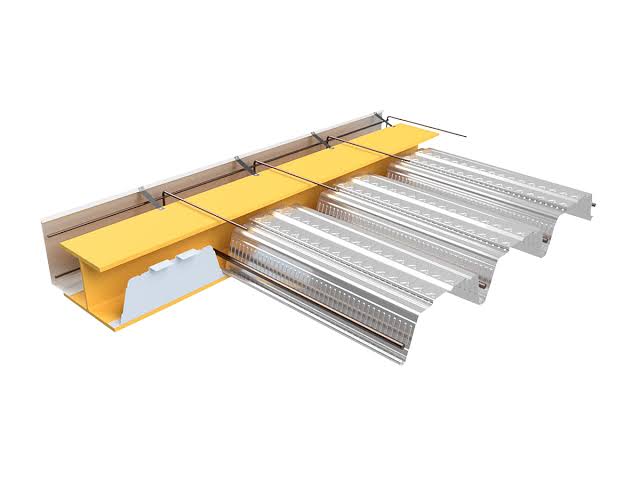This article highlights the various options of floor systems available in steel-frame buildings. It discusses their unique features, advantages and disadvantages.

One of the very first considerations at the concept design stage of any building is selecting a floor system. The designer must choose the most appropriate floor system for the scheme, from a list of available options. This often requires a thorough consideration of many important parameters such as, cost and simplicity, speed of construction, buildability, aesthetics etc. These are briefly explained below:
Cost & Simplicity: A designer must aim to select the simplest solution that ticks all boxes of the project requirements. Typically, it is often the simplest solution that does it, and the simplest option in turn is often the most cost effective.
Speed of Construction: The speed of constructing different floor types varies depending on the floor type. Sometimes, the need to reduce the overall construction time could play a determining role and may drive the chosen solution.
Buildability: The designer must consider the likelihood of the prospective contractor having the expertise required to implement the floor design.
Aesthetics: The visual appeal of the finished building. For example, where the soffits of the floor are to be exposed, some floor option may not be considered very appropriate.
In multi-storey steel buildings, the floor system in addition to their vertical load carrying function must act as a horizontal bracing or diaphragm. In other words, the floor is required to ensure all lateral forces are carried to the vertical bracings from where the forces are then transmitted to the ground.
This article, presents a range of floor systems utilized in multi-storey steel frames, with the advantage and disadvantages of each system compared with requirement of a project. Seven floor systems are listed and afterwards described. These are:
- Short-span composite beams and composite slabs on metal decking
- Long-span composite beams and composite slabs on metal decking
- Composite beams with precast concrete units
- Non composite beams with precast concrete units.
- Slimdek
- Cellular composite beams with composite slabs and steel decking.
- Slimflor beams with precast concrete units
Short-span Composite Beams and Composite Slabs on Metal Decking
Probably the most basic and commonly used flooring system in multi-storey steel-framed building, the floor system works on the basis composite action between a steel beam and a concrete slab. The floor system typically, consist of down-stand steel beams having shear connectors welded to the steel beam top flange and connected to the floor slab (Figure 1). In its final form, the floor slab would comprise of a shallow ribbed metal decking and a concrete slab topping. Typically, the slabs are 125-200mm thick with the metal plates having a thickness in the range of 0.9 -1.2mm depending on design requirement.

This floor system is generally utilized where the slab spanning requirement is not stringent (between 3 -4m). This could mean that secondary beams are introduced to be supported by primary beams in-order to reduce the span. In any case, both the primary and secondary beams must act compositely with the slab, except in the case of the beam being an edge beam.
The floor system is often required to support it own weight during the construction, hence the designer of this floor system must consider two load conditions: construction stage and composite stage. At the construction design stage, the slab is treated as a continuous member with at least two spans under the construction loading of the wet concrete while at the composite design stage the slabs however continuous, are treated as simply supported members.
The slab topping does not require reinforcing steel; however, mesh reinforcement is normally provided to reduce the effect of cracking.
Advantages
The primary advantage of this floor system is the composite action occurring between the steel beams and the slab. This allows for the required steel beam sections to be shallower, in turn economical and thus the overall floor being lightweight. Another advantage is that this form of floor system allows the decking to also serve as the formwork at the construction stage, thus eliminating the extra cost that would’ve otherwise being spent on formwork.
Disadvantages
This floor system requires more columns or closely spaced supports, hence would be unsuitable where long spanning is a basic design requirement. Compared to more shallower floor options, it is considered to have a deeper overall floor zone. Due to their exposed nature, the steel beams generally require fire protection.
Long-Span Composite Beams and Composite Slabs on Metal Decking
The system is not different from the ‘short-span composite beams and slabs on metal decking’, this form consist of composite rolled steel sections supporting a composite slab, however in a long span arrangement (Figure 2). The floor system can either be made to consist of long span secondary beams spaced at 3-4m centres or short span secondary beams spaced at (6-9m) and supported on long span primary beams. The depth of the primary beams is a very important factor in the design of this floor system, where service zones are required, they must be totally accommodated within the web of the beam or openings may be provided to solve this problem.

Advantages
Their strength is their suitability for long-span floor construction and large column-free spaces.
Disadvantages
They have a much deeper floor zone and produce heavier steel-work than the short span solution and requires fire protection for 60min. and above
Composite Beams with Precast Concrete Units
This floor system consists of a rolled steel beam with shear studs welded to the top flange. The beam supports precast units with a structural concrete infill over the beam between the end of the units and an additional topping covering the units (Figure 3). Precast units are either made to be hollow core with thicknesses of (150-260mm) or they are made of solid planks of (75-100mm).

This floor system is typically suitable for spans of 6-9m steel beams and precast units.
Advantages
Because this floor system allows long span precast units, the number of secondary beams that would normally be required is effectively minimized.
Disadvantages
The steel beams are highly susceptible to torsion and may need stabilization at the construction stage. This floor system requires more individual lifting operation compared to the erection of a decking.
Non-Composite Beams with Precast Concrete Units
The floor system (Figure 4) consists of rolled steel beams supporting precast units, here the precast units can either be supported directly on the top flange of the steel beams or on shelf angles to reduce construction depth. Precast concrete units are generally grouted in position and are either made to be hollow core with thicknesses of (150-260mm) or they are made of solid planks of (75-100mm).

Non-composite beams with precast unit floor system are most common with spans of 6 -7.5m.
Advantages
Similar to the composite beam solution.
Disadvantages
Similar to the composite beam solution.
Slimdek
A Slimdek floor system comprises of asymmetric steel beam (ASB) sections supporting a heavily ribbed composite slab with 225mm deep decking (Figure 5). An ASB is a steel beam with wider bottom flange and with an embossment rolled into the top flange acting compositely with the concrete slab. In this case the embossment replaces the role of a shear connector. This decking is very similar to the composite slab with respect to construction. It is able to serve as the formwork and sustain the construction loads at the construction stage. However, in the case of a Slimdek, the concrete slabs encase the steel beams apart from the bottom flange that is exposed.

Slimdeks are suitable for steel buildings with a typical grid of (6-8m) that can accommodate a slab of 280 -350mm. Reinforcing bars are often required in ribs for fire resistance requirement and to improve the composite action in the final condition. Mesh reinforcement is provided in the slab over the ASB section. If the top of the slab flushes with the ASB then there’s a code requirement to tie the slabs in both sides of the ASB by providing rebars in the slab.
Advantages
A Slimdek is identical to a typical concrete flat slab, hence has similar advantages. Its reduced overall depth, means that the overall building height and cladding is reduced. Also, when positioning internal walls, the flat soffits offer some flexibility.
Disadvantages
The primary disadvantage of a Slimdek floor is its weight. When compared with other floor options, its self-weight is huge. Since a Slimdek floor utilizes asymmetric steel beams, the steel connections often require careful detailing due to the width of the bottom width.
Cellular Composite Beams with Composite Slabs and Steel Decking
This operates on the same principle of composite action between steel beams and concrete slab. However, in this case, the steel beams are provided with openings at regular intervals along their length, these steel beams are called Cellular beams (Figure 6). The openings are normally circular but sometimes can be rectangular or hexagonal. At positions of high shear forces such as at supports or where a concentrated force is acting, the opening might be avoided to increase the shear resistance of the section. Generally, the size, spacing and location of the opening is often dictated by design requirements.

When cellular beams are utilized in floor construction, they could either be arranged as long span secondary beams supporting the floor slab directly or as long span primary beam aligned parallel to the span of the slab supported by other secondary cellular beams or rolled steel section. They’re typically suitable for a span of 10-18m.
Advantages
They’re typically suitable for long span slabs; where having an uninterrupted clear span is a primary design consideration. Compared with other long span option, they offer the best solution in terms of self-weight considerations, this also suggests that they’re cost effective. Finally, the openings present in the beams aid flexibility during installation of building services.
Disadvantages
The disadvantage of this floor system presents itself in the cost of fabricating the cellular beam when compared to plain steel sections.
Slimflor Beams with Precast Concrete Slabs
A Slimflor is a floor system in which the supporting steel beam is embedded fully within the structural floor depth. In this floor system, a steel plate (usually 15mm thick) is welded to the underside of a UC section to meet the Slimflor beam (Figure 7). The plate extends beyond the bottom flange by 100mm either side, supporting the precast floor units. And, a structural concrete topping with reinforcement completes the system. According to design requirement, the topping thickness should at least be 30mm.

Composite action can also be achieved with a Slimflor by providing shear connectors to the top flange of the UC sections and reinforcements placed across the flange into slots prepared in the precast units. Where the steel beams have being designed compositely, the toppings must cover the shear connectors by at least 15mm and the precast units by 50mm.
Slimflor are typically suitable for spans of (4.5 -7.5m).
Advantages
Just like the Slimdek, they offer a shallow floor zone and by extension reduced building height. However, they’re primary advantage is fire resistance. Because the steel beams are fully embedded in a concrete section, they often do not require any fire resistance for up to 60minutes.
Disadvantages
First of all, they’re relatively heavy. Second of all, a Slim Flor attract extra cost as a result of the need to weld plates to a UC section. Lastly, the use of precast unit means that more individual lifting operation will be required than would otherwise be necessary in the case of an in-situ decking.
See: Concrete Slabs in Concrete Frame Building
Sources & Citation
- Brown D.G. (2009) ‘Steel Building Design: Medium-rise braced frames in accordance with the Eurocodes and U.K National Annexes’, Steel Construction Institute.
- BE EN 1994: Design of Composite Steel and Concrete Structures.
